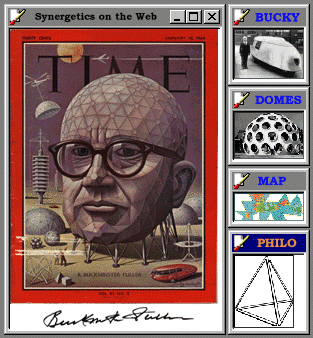This is one of several websites focusing in some way on an invented language, originally designed by R. Buckminster Fuller (b. July 12, 1895, d. July 1, 1983) to communicate his "explorations in the geometry of thinking" (the subtitle of the work).
Fuller was a self-declared comprehensivist and often wrote about the cultural chasm identified by C.P. Snow, separating the humanities from the math-sciences. That's the chasm he set out to bridge. Synergetics is the result.

|
Those trained in the humanities, on the other hand, may be turned off by its starkly geometric terminology, which perhaps strikes them as too cold and unfeeling. In other words, in attempting to cross Fuller's bridge, people on either side of C.P. Snow's chasm tend to confront their prejudices about the other side's style of communicating. A lot of would-be readers turn back, frustrated by an overwhelming sense that this work must be primarily intended for someone else.
Fortunately for future scholars, Ed was highly sensitized to what he calls the psychological aspects of Fuller's self-discipline (it was his idea to put Pronouns in the index) -- even though he scanned it for more points of contact with the physical sciences as well. Their close collaboration allowed synergetics to mature into the high bandwidth discourse we find in the original two volumes, Synergetics and Synergetics 2, published by Macmillan in 1975 and 1979 respectively.
But Ed also functioned as a filter, helping to distill an aspect of Fuller's thinking to its essence, whereas in his multi-hour lectures on the global circuit, Bucky tended to converge this starkly geometric language with more historical and socio-political discourse -- present, but muted, in Synergetics.
In Grunch of Giants (1983) and Critical Path (1981), volumes for which Kiyoshi Kuromiya served as adjuvant (catalyst), this other aspect of Fuller's thinking comes more to the fore. Again, we are fortunate that Bucky found talented collaborators at multiple points along the spectrum.
My personal conclusion is that Synergetics represents a lasting contribution to philosophy and will prove a source of inspirition for many future generations. Fuller supplies some valuable core curriculum for students from many walks of life.
However, here at the end of the 1900s, Synergetics is languishing for lack of readers. Part of the difficulty is a the scarcity of positively oriented secondary literature, although we have a growing amount of that, Amy Edmondson's A Fuller Explanation (1987) in particular (Hugh Kenner's Geodesic Math and How to Use It provided an even earlier boost -- as have other writings by Hugh about Bucky).
Thanks to the internet, and especially the World Wide Web, scholars now have a much easier time assisting one another in overcoming some of the hurdles to reading and appreciating Fuller's lasting contributions to our shared metaphysical heritage as humans in Universe.
I consider it a privilege to shed whatever light I can on this subject, noting up front that I'm clearly a biased individual with my own slant on stuff. I provide many links to other websites where the presentation may be substantially different.
In fact, my own viewpoint has continued to change over the years, as anyone making repeated visits to this website over time might attest. So come back again soon. I may have additional insights to share with you by then.
Finally, I should forewarn the casual browser that this site is not exclusively devoted to providing a rehash or even a critical interpretation of Fuller's material; I also use it as a platform to develop my own brand of curriculum writing.
In retrospect, perhaps I'll be seen as defining a branch or an off-shoot of what might be more inclusively known as the Fuller School -- an invisible college or global network of some kind.
As is the case with Kiyoshi and Ed, Amy and Hugh, and many
others, I have my own relationship with Bucky, and in many ways
this website is the result of another collaborative effort, albiet
a somewhat long-distance one.
Kirby Urner
4D Solutions
June 22, 1999